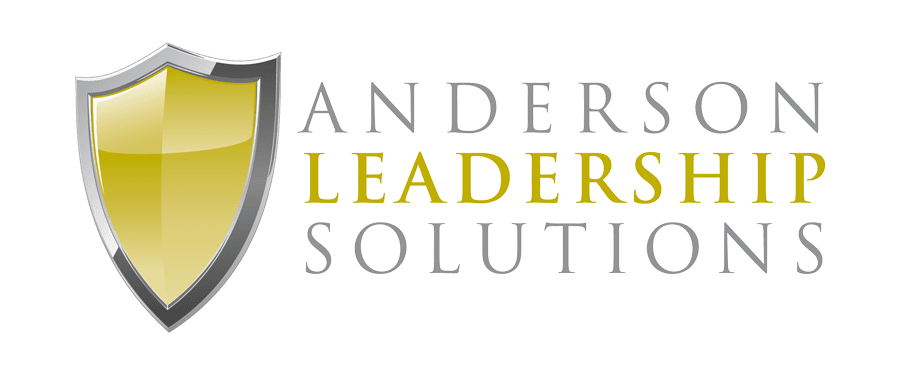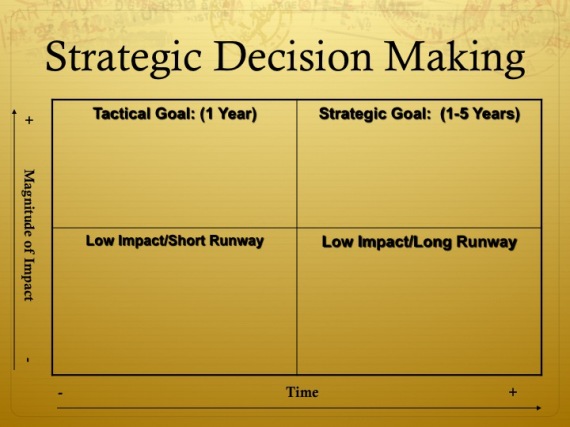New Year’s Goal Setting – A Simple Model
What are my priorities for this year? What accounts and what goals should I focus my efforts on? The time is now to ask these questions. Do not wait until after the holidays.
I sat in many, many strategy sessions for individuals, small teams and large organizations. They can be a beat down or very productive and energizing.
Somewhere along the way I picked up a tool that helped me clear through the clutter of brainstorming sessions and simplified my action planning.
When Strategy Sessions are a Waste of Time
Too many strategy sessions I sat in were simply brainstorming run amuck. A lot of great ideas where thrown up on a flip chart and discussed. We got bogged down during brainstorming sessions when people tried to qualify ideas DURING the brainstorming.
Plus, the qualifying often revolved around HOW to implement an idea instead of discussing whether we SHOULD implement it.
Brainstorm First – Then Qualify
During brainstorming, opinions of the ideas hurt the creative process. Opinions need to be controlled and held back until the brainstorming is over.
Impact and time to impact should not be evaluated during brainstorming. Once the brainstorming is over, it is time to qualify the ideas using the 4 Box Grid pictured above.
The most effective strategy sessions drew a clear line between brainstorming ideas and qualifying ideas. To qualify good ideas, I like to look at two things:
1. The Potential Magnitude Of The Impact of The Idea
Along the Y Axis of the 4 Box Grid, I would plot whether the idea would have low impact or high impact (Revenue, relationships, etc.)
2. The Time Needed To Realize That Impact
Along the X Axis, I then determined whether the idea could realize that impact in the short term (within 12 months) or the long term (1-5 years).
Getting A Visual
By plotting the ideas in the proper quadrant, I could narrow down all the good ideas and find the best ones. Though I fell in love with some highly creative ideas, I might realize they required a longer runway and had lower potential impact than more mundane ideas.
Visualizing these ideas on the grid quickly made it clear to me where time and resources should be invested.
Priority #1: High value-short runway goals.
These are my 12 month goals. They have the potential to move the ball down the field the furthest in the shortest period of time.
Priority #2: High value-long runway goals.
These are strategic goals that need attention and strategic planning to obtain. This is the #2 priority for me because these will determine my future, my team’s future, or the future of the organization as a whole.
A leader must be able to envision the future and determine strategies that will ensure success beyond the next 12 months.
Priority #3: Low value-short runway goals.
These are targets of opportunity. If you can get it done, do it. But, only if the opportunity is not replacing a higher impact goal.
Priority #4: Low value-long runway goals.
Why? In my experience these are things that were historically done but rarely evaluated for impact. They are habits of operating that need to be eliminated.
How Many Goals?
How many goals should I have? (Hint: It is fewer than most people think.)
This is another area that individuals and organizations struggle with. Click on the following blog title to read more about effective goal setting and the number of goals we should have:
The Bottom Line:
Priorities are NOT created equal. The newest and the shiniest ideas can distract people from the best ideas. If I want this year to be a success, I must do a good job at determining my top priorities.
New ideas are great. The creative ones capture my imagination easily. But if I don’t understand their potential impact and how long it will take to realize that impact, I am in danger of moving in the wrong direction in the next 12 months.
Our success over the next 12 months will be determined by how effective we are at setting our priorities. This system is simple and effective for individuals and teams. Good luck in the new year!
Question:
What questions will you ask yourself to qualify your goals and priorities for next year?
PS. Help me write my book with my dad. I need to know who your leadership hero is and why they are your hero. It will take 2 minutes to do this and will be a big help to us. Thanks in advance! Click below:


Thank you for sharing. The grid is useful and the discussion about it even more. As the world becomes more technical and software based, this discussion would benefit from recognizing the role and impact of IT in achieving many of the tactical and strategic goals set. For example, most strategic goals for companies may never be fully realized without the proper IT infrastructure and operations to support them. If not managed well, the effect is a flat line or even downward curve over time. IT architecture and support is not free though so the magnitude of impact (read, business revenue) may be delayed, but that is better than little to none at all, which may eventually jeopardize the very existence of the company or cause its acquisition – all of which are very commonplace today. In short, corporate agility and survival are increasingly centered on IT, like it or not.
That is true. Those goals may realize the impact in the long term but are not less important. They will be the strategic goals that the upper management works on while the front lines maintains focus on the tactical (short term) goals that will create revenue in the next 12 months.